The main question is: Should you just pull the avocados off the tree, or should you carefully clip the stems when you harvest avocados? Let me tell you what I do and explain why.
Harvesting avocados by hand
Whether my feet are on the ground or I’ve climbed up into a tree using the branches or a ladder, if I’m harvesting avocados by hand (not with a pole) then I usually break the stems in half to remove the fruit. I don’t try to pull the avocados off the branches because that sometimes breaks the branches.
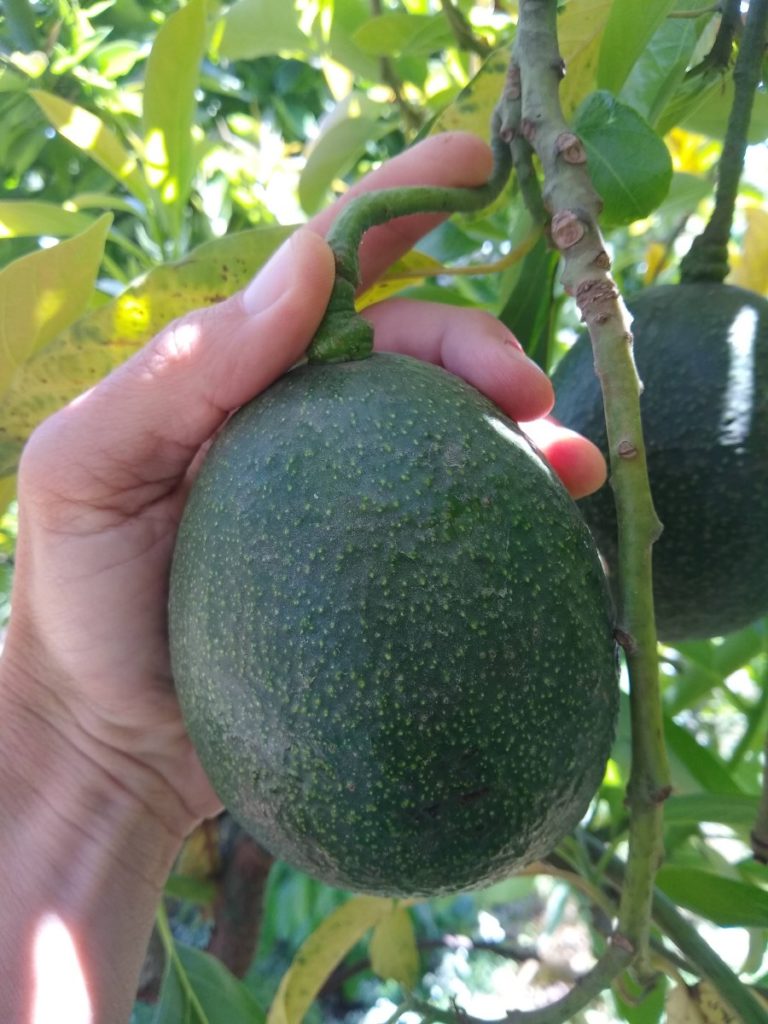
After I’ve picked as many as I want, I’ll use clippers to shorten the stems so that there remains a stem button.
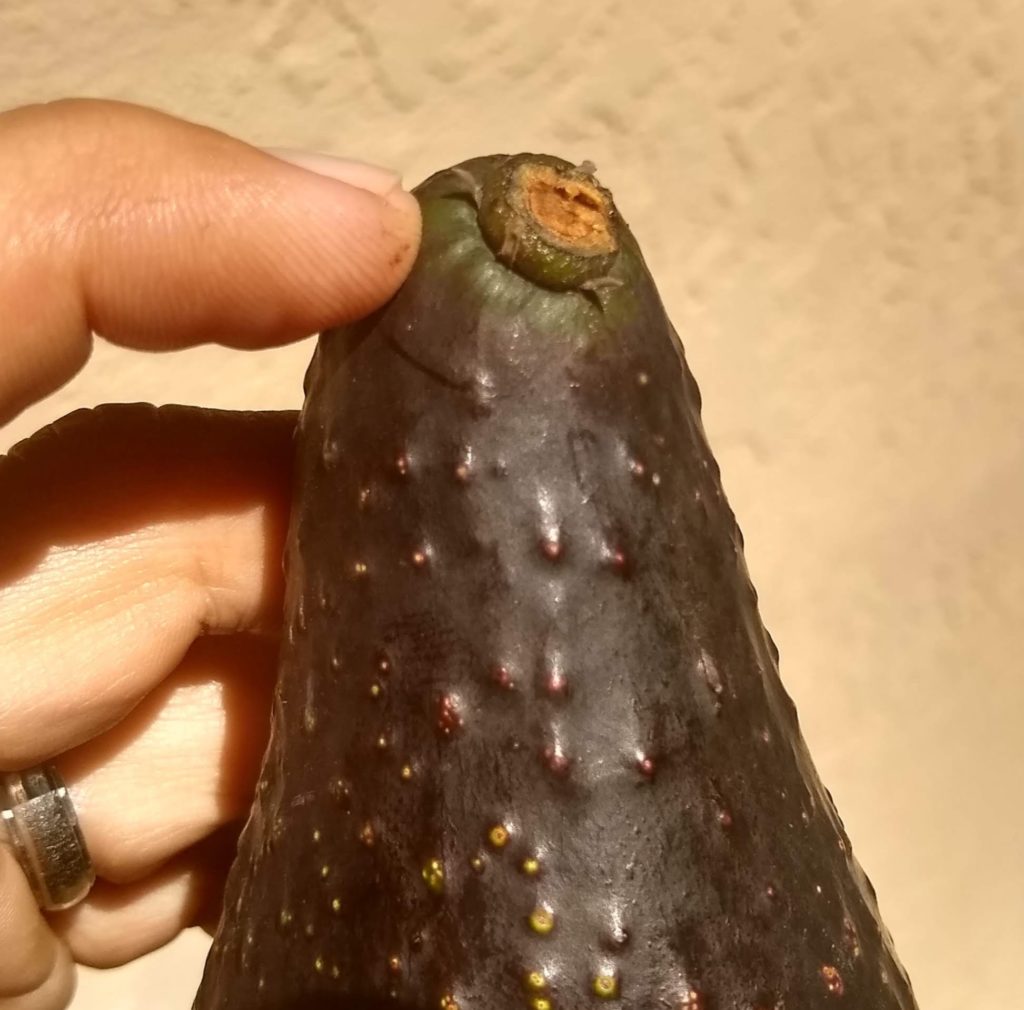
I often like to have a button on avocados because it helps me know when they’re ripe. I can wiggle that button to tell. When an avocado is ripe, the button will easily wiggle out. If it does, I usually also sink a toothpick into the stem hole to be sure I don’t cut it open to soon. (I’ve cut open Pinkertons early too many times!) A toothpick will easily sink into the flesh if the avocado is ripe.
Why not just snap the whole stem out of the avocado upon harvesting?

Sometimes instead of leaving a button in the avocado, I “snap” harvest and remove the entire stem, button and all. I do this with Hass, for example. It’s easy for me to tell when Hass is ripe so I rarely need to wiggle a stem button or insert a toothpick to test.
Additionally, there’s nothing risky about snap harvesting in terms of how the avocado ripens afterward. For example, I’ve never noticed rot occurring at the stem end more often when the stem button has been removed compared to left in, and some formal studies confirm this.
“In general, fruit quality of “snap” picked fruit was as high as, or higher than clipped fruit,” wrote Mary Lu Arpaia of U.C. Riverside in a study of Hass avocados harvested in different parts of California.
Also, the method of harvest — snapping or clipping — hasn’t been shown to significantly affect how fast an avocado ripens. (See this report on an experiment done by Irving Eaks.)
Harvesting avocados with a pole
There are two types of poles that can be used to pick avocados from a tree, one with a blade or set of blades that cuts the stem and one with fingers connected to a basket that grasps the fruit and pulls it off. They’re usually called clipper poles and basket poles.
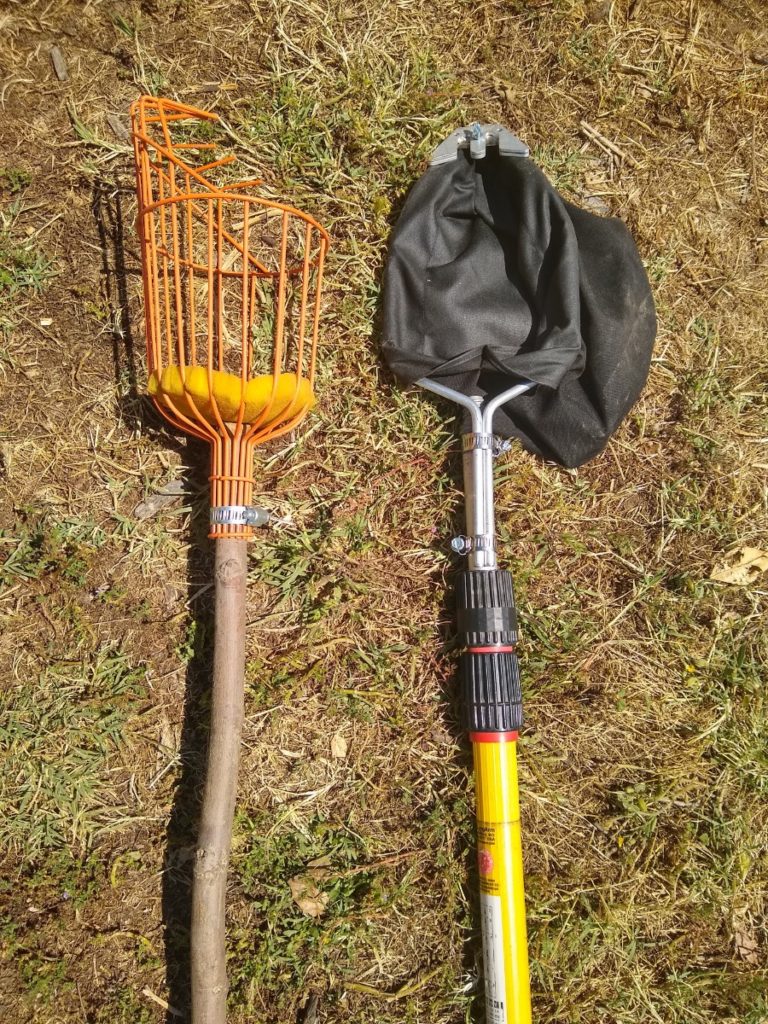
I like to use a clipper pole as my first option because it ends up pulling down fewer branches while harvesting avocados. But clipper poles have a hard time reaching some fruit that is tucked between branches or that is very high. For such fruit, a basket picker works better. I attach a basket to a painter’s pole that extends to about 25 feet.
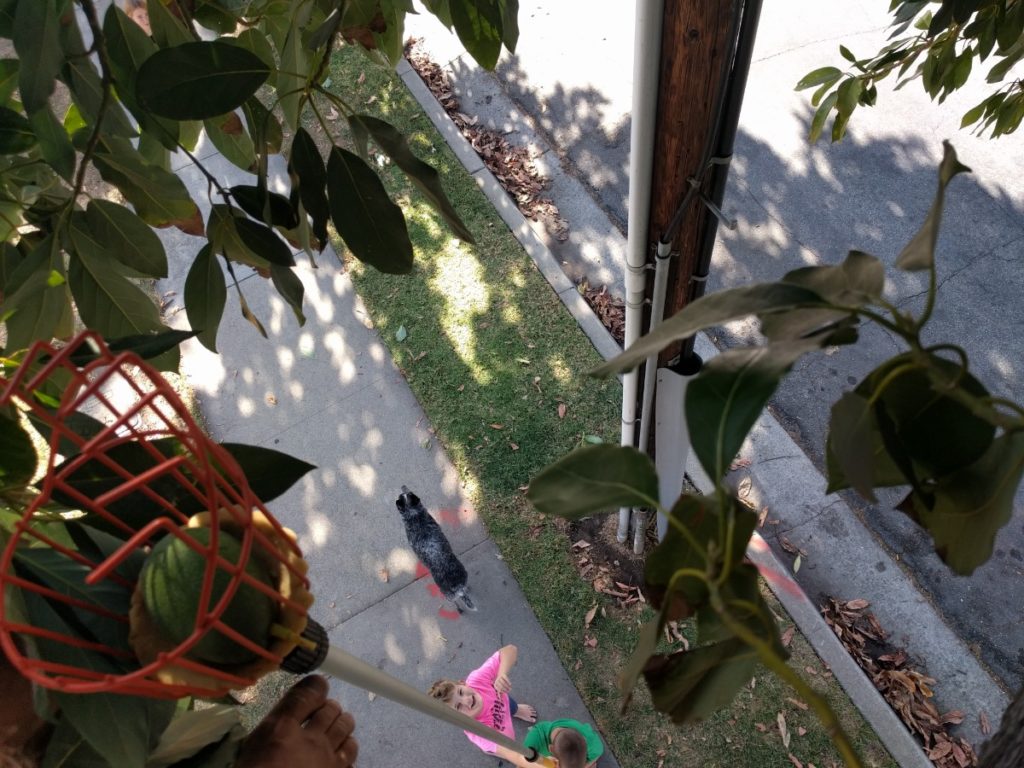
Harvesting conditions
Is there a best time of day to pick avocados? Are there any conditions in which you should avoid harvesting avocados? I pick avocados at all times of day, even in the afternoon in the heat of summer. Commercial avocado growers try not to harvest in the middle of the day when it’s hot but that’s because they aren’t able to bring their avocados into a cool kitchen immediately like we can. I’ve harvested avocados when it was over 100 degrees, immediately brought them into the house, and the fruit has still ripened perfectly.
But do not harvest avocados in the heat and then let them sit in the heat, even in shade. I’ve made that mistake, and it ends with the fruit ripening poorly with off flavors and rotten spots.
At the other extreme, I avoid harvesting when it’s wet. Here’s why: “An interesting side outcome of the California research [done by Arpaia and linked to above] was the demonstration that the number of decayed fruit increased immediately after a rain regardless of picking method . . . The lesson learned is that avocados should not be harvested by either [snap or clip] method during or immediately after rain and before the trees have adequate time to dry out.” Reuben Hofshi wrote this back in 2002.
It’s interesting to note that commercial avocados in California continue to be almost exclusively clip harvested even though Arpaia’s research was done more than twenty years ago showing that snap harvesting yields fruit with as little or less stem end rot during normal dry conditions. Of course, snap harvesting is also much faster, and so more efficient and cheaper (if you’re paying someone to harvest your avocados). I guess old habits die hard.
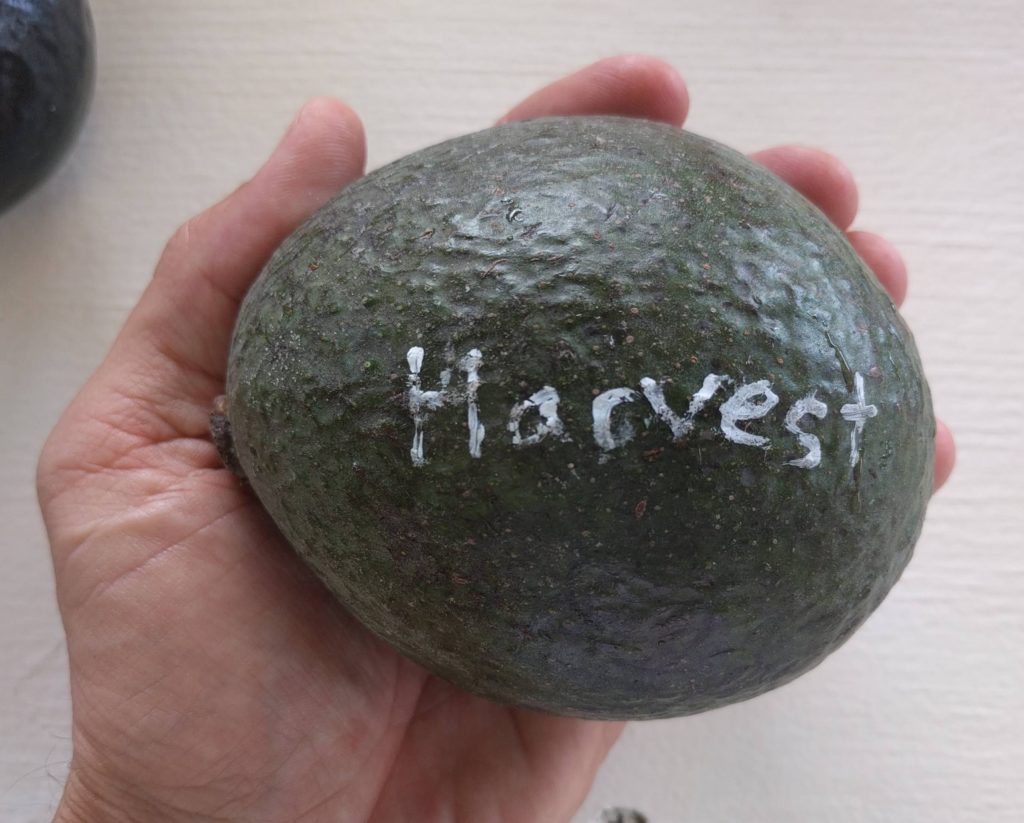
You might also like to read my post: “When to pick avocados.”
A list with links to all of my Yard Posts is HERE.



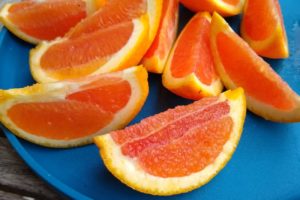
Oh this is all wonderful information that I need, thank-you so much!
So interesting and valuable info! My little trees have yet to produce, but I know this is going to come in very handy soon (or 10 years at the rate my little trees are growing lol)
Thank you! ?
How’s the Gillogly Greg?!
Hi Vince,
I don’t know yet! A friend let me pick a handful from her tree the other day, but they’ve yet to ripen. I’ll try to do a short profile after I’ve eaten a few. They sure are strange looking avocados.
I’m hopeful that someday I’ll have a need for a pole picker, as my trees are pretty small now. I needed to drive up to Riverside to pick up my trailer so on the way back I splurged and bought a 2 foot box Fuerte from Maddock and stopped by Subtropica and bought four small bag avocados: Reed, Edranol, Kona Sharwil, and Nabal. I’m going to plant them in and around my existing avocados and prune as needed to let them grow.
The Pinkerton and Stewart I put in last October are doing better than any other avocado I’ve ever planted and I’m guessing it’s due to the prep I did. I built up a rail road tie planter and filled it with decomposed granite, planted the trees, covered with compost and topped it with wood chip mulch. when winter ended I put up shade cloth and so far so good.
Thank you, Greg, for all of your informative articles.
Great to hear all this, Bob. Doesn’t Maddock grow the most beautiful big avocado trees in 24-inch boxes? You pay for them, but they’re big and beautiful. On the other end of the spectrum, almost every time I stop by Subtropica I buy a tree because they offer so many varieties and the trees are small and very affordable.
I love to hear reports of avocado plantings like yours, where a bunch of effort was put in to raise the planting and ensure good drainage. (Not that this is always necessary in all soils, of course.) I can’t recall hearing of a time when such preparations didn’t pay off.
Hi there Greg,
Called Baron Brothers Nursery in Camarillo yesterday to see if they had all of the avocado varieties that I wanted and was strongly discouraged by the rep to not plant avocados in Agoura. She used to live right up the street from where I am now and she said it’s just a strange little microclimate here that makes it almost impossible to keep the trees healthy and get any fruit. 🙁
On a more cheerful note, she suggested that we can plant Bing and Stella Cherry trees!
BTW, Gus from Agoura, if you are out there, I would still love to know how your avocado plantation is doing, I tried to find you on NextDoor but to no avail. How are your avocados? Thanks Greg!
Hi Rachelle,
This bothers me. I’m extremely interested in hearing more about this. What I most want to know is the specific reason(s) given by the nursery rep for not planting avocados in your neighborhood.
When I moved into my current house I was told by a Master Gardener who lived in my neighborhood that I was “pissing away my money if I planted avocados.” (I’m in Ramona.) I was also told by other neighbors that they’d planted them and the trees failed. I got a little scared, but I kept planting avocado trees. There were a few mature trees in the neighborhood that belied this discouraging advice, and I knew that it was somehow possible. Almost seven years later, I’ve lost some trees and had plenty of challenges, but I now share avocados from my trees with some of these same neighbors.
From the cherry comment, it sounds like she was implying that your yard is too cold in winter for avocados, but I’d be very surprised if this were true. My guess is that your level of winter cold is only a significant challenge for avocado trees in their first couple years. But if you choose the right varieties and protect the trees on a couple of cold nights during the first couple winters you’re likely to be fine from then on except for during rare cold events.
Any idea how cold your yard gets? Mine hit a low of 25 for a few hours on February 5 this past winter.
The bottom line is that growing avocados in Camarillo is far easier than growing avocados in Agoura, but I can’t imagine where in Agoura it would be almost impossible because of climate. Don’t be discouraged unless you can get concrete, specific explanations.
I discovered snapping the avocado stem to pick the fruit out of necessity – I was on the top of the hill and did not have my cutters. I would like to add that I discovered that snapping in a certain direction and area works the best. Typically, on Hass, above a joint area. If you have a stringy situation where is did not break cleanly, try rotating until you find the sweet spot and with practice you can get a clean easy break each time. Another way I pick is by going to the top of the stem the avocado is hanging on and pushing it up, so the entire stem breaks free from the branch. They break away easy this way and you can carry a bunch by the stems very easily as well. I find the main reason for leaving a stem nub is so when the avocado is ripe you can remove the nub just before eating and the area below the nub is usually soft and green rather than dried out and brown.
Rick, Thanks a lot for these additions. Very helpful!
Thanks for the informative post Greg. I know you were considering this prior to my request in a different post, it came much sooner than I expected. Your passion for growing food (especially avocados) and help others be successful doing so shines through again.
Thanks, Matt. This post came sooner than I expected too. I was writing about fertilizing vegetables when I suddenly trashed it and decided to do this one you prompted about harvesting avocados.
Hi Greg,
Thank you for your reply. Yes, she used to live in the neighborhood and she cited cold as the main issue. I would be happy to try,however I’m just the garden planner and my husband is the one who really does most of the labor. If I was digging the holes, I would go for it, but I hate to have him work so hard and end up with failure. We have literally no avocado trees in the area I’ve not seen one and one of your readers (Hi Gus!) has a newer plantation but we don’t know how his avocados are doing. For right now, I might just have to be satisfied with a huge case of avocado tree envy!
Have you tried out the pull and cut type pickers? I just got one last month and love it so far but don’t have much experience with it yet. Ease of the basket but get a nice clean cut on the stem and drops in to a soft bag. Is there any downside you have heard of to these? I hear they are used more than the traditional style cutter I’ve seen used for years around here (SB/VTA County) down in Mexico and Chile.
Hi Casey,
No, I haven’t used the clipper poles with a rope attached. I do need to try one out to see how it compares. The only downsides I can imagine are the cumbersome quality of the rope, as with what happens while using a pole pruner; but I’d guess that would be overcome by learning to use the tool well. And then there’s the fact that you’ve got moving parts, which requires care like cleaning and lubricating, just as with a pair of pruning shears.
Not to promote any products but these are the style pickers I’m referring to. Just recently started to use it and really like it. Mine is not this one and is from another company that doesn’t seem to have a website working (Avoamigo).
https://www.loboproductsinc.com/product/fruit-picker-head-bag-mex-avocado-picker/
https://www.youtube.com/watch?v=AqVcLvRnaAg
Hi Casey,
I misunderstood. I thought you were talking about a picker with a rope that you pull to cut the stem.
Yes, I have used the “pull and cut” type picker that you linked to. Mine is neither of those brands, but I am familiar with Avoamigo. A guy at Grangetto’s talked to me about them once. They felt and looked good.
Thanks for sharing the video. Cool to see those guys pick so fast and skillfully.
Hi Greg, I’m having trouble with my avocado trees. I have a Haas and a Fuerte tree and both show signs of severe spotting on the leaves. I have read that this may be caused by a persea mite. Can you recommend a product or solution to eliminate these mites.
Thanks for your forum.
Brian
Hi Brian,
Here is a great page with information about mites on avocados, including identifying which kind you have and management suggestions: https://www2.ipm.ucanr.edu/agriculture/avocado/persea-mite/
How do you know WHEN to harvest an avocado? I had three on a tree I bought last year. I waited and waited for them to darken to look like the ripe ones at the store, but they never did. After many months I picked them thinking “Maybe they’ll ripen once picked.” They didn’t. I now have a bag of very green and hard fruit that my daughter gave me from a U-pick farm she works at (someone picked them and they weren’t supposed to.) They are good size and resemble store avocados except they aren’t close to ripe. WIll they ripen? Or are they ruined? In unrelated news, your blog has encouraged me – I now have 6 avo trees – 3 or four varieties, As & Bs. Most are doing well, so far.
Hi Alan,
I hope this post will give you some guidance: https://gregalder.com/yardposts/when-to-pick-avocados/
Good to hear about your avocado trees. I hope they are a pure blessing and not the start of an obsession!
Doh! I shouldn’a stopped at the first search result! I’ve read the other post in its entirety – it seems pretty complicated! I have a couple Zutanos (mainly to pair with the Hass), which are not charted, but, more importantly, I currently have ZERO fruits on any of the six relatively tiny trees, so, I probably have a few years to figure it out!
Hi Alan,
I plan to expand the harvest chart in this post soon, and I will adjust the dates on a few varieties too. For Zutano, it’s basically the same as Bacon which is roughly December to March. But remember that these dates always vary a bit each year and according to location within Southern California. The challenge with making a harvest chart too is that everyone likes their avocados at slightly different maturities. I have a friend who loves late season fruit that is very oily, but to me this fruit often tastes heavy and even cheesy and off-flavored. Some others like to pick as soon as the fruit will ripen properly. I try to show the harvest dates for each variety that is about in the middle.
I have a 10 yr old beautiful Hass avocado tree….it produces beautiful fruit – quite a lot every other year. This year has been a good year and I have been picking fruit since November. The tree is full and now most of the fruit is up very high. I’m concerned about getting all the fruit off as I have been told, and follow the advice, that all the fruit should be off the tree before it blooms – which it usually does in April/May. I’ve been told, the tree will not bloom well – or at all – if fruit is still on the tree. Can you verify that or give me some info about that issue?? Thanks so much.